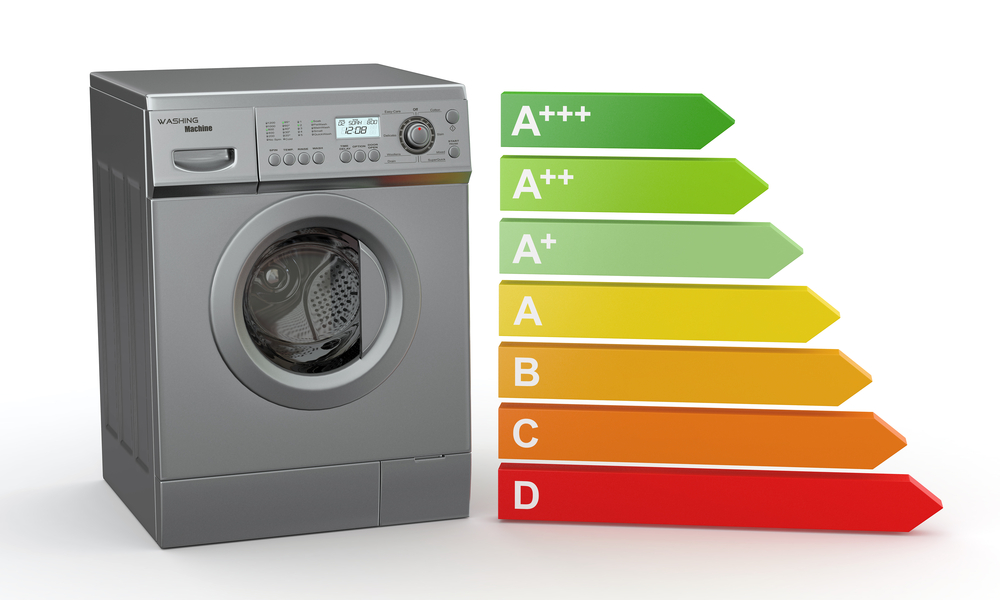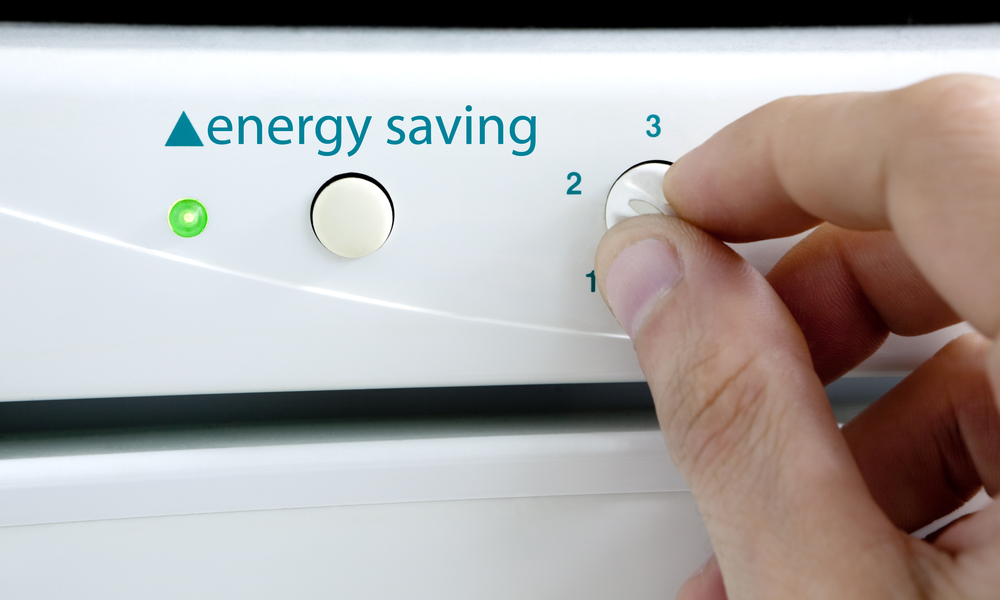10 Energy Star Certified Home Appliances

Turning off the lights and unplugging appliances that are not in use are some of the ways you can reduce your energy consumption. They do work, at least to a certain extent. But if you really want to see significant savings on your electric bill, you’ll need to employ a multi-pronged approach to your energy-saving goals. Choosing energy efficient appliances to replace your old models is one more technique you can try to whittle down your utility expenses.
According to the U.S. Department of Energy, by employing energy-efficient measures, you can lower the amount you spend on power by 25%, which translates to over $2,000 in a year.
Verifying Energy Efficiency
In the process of converting one form of energy into another, a portion of the energy that’s available initially dissipates, usually in the form of heat. Energy efficiency is the amount of energy used to produce a different form of energy. You can calculate it manually by dividing the energy obtained (or energy output) by the initial energy (or utility energy input). A simpler way is to use an online calculator.
Energy Star Appliances
Energy Star is a program developed by the Environmental Protection Agency (EPA) and U.S. Department of Energy (DOE). The program’s goal is to help consumers save money and the environment by using products that utilize electricity more productively than standard models.
To earn an Energy Star rating, the product must pass the strict energy-efficiency criteria set by the said government agencies. Thus, appliances bearing the Energy Star label are energy-efficient products, which are certified to use less energy. Not only do these appliances help save on utility bills, but they also benefit the environment because less energy consumption means fewer harmful emissions from fossil-fuel-based power plants.
Energy Efficient Appliances
Studies show that household electronics like clothes dryers, washers, refrigerators, dishwashers, air purifiers, air conditioners, and humidifiers account for approximately 20% of your home’s electricity consumption. The average life of a household appliance is between 10-20 years, and Energy Star-certified ones generally use around 10-50 percent less energy per year compared to non-energy efficient models, which could amount to substantial green bucks over time.
1. Air Conditioners
According to the Environmental Protection Agency, room air conditioning units with the Energy Star label cost $75 less to operate per year than those with no Energy Star certifications. That’s because Energy Star-certified models use better quality insulation materials, which help maximize efficiency.
On top of that, their highly efficient compressors and fan motors provide cooling comfort while using less electricity than those that do not qualify for an Energy Star label. This makes an air conditioner bearing the Energy Star seal an excellent choice.
2. Ceiling Fans
Ceiling fans circulate the air in the room, making it feel cooler during hot summer days and reducing the cooling that should otherwise come from your AC unit. Using a ceiling fan, you can typically lower your thermostat by 4 degrees and still feel nice and comfy.
If you’re planning to install ceiling fans, a proven energy saver is a model that comes with an Energy Star label. Units with the Energy Star certification offer 20% more energy efficiency than standard models.
3. Air Purifiers & Dehumidifiers
Air purifiers help keep indoor air free of dust, cigarette smoke, pet dander, and other irritants which can trigger allergic reactions in susceptible members of your family. But running air purifiers means more energy use for your home as a standard model that operates 24/7 consumes around 550 kWh annually.
One of the energy-efficient upgrades you can opt for is an Energy Star-certified air purifier, which is 40% more energy-efficient than traditional units. With this upgrade, you can save around $30 a year on energy costs.
Meanwhile, dehumidifiers remove extra moisture from the air, letting you reduce energy use on your cooling needs. Energy Star-certified portable and whole-home dehumidifiers consume around 15% less electricity compared to a traditional non-energy-efficient model.
4. Heat Pumps
Both a heating and cooling device, heat pumps remove excess humidity in your home during summer to help cool the area. Meanwhile, during winter, they suck in the heat from the outside air and use it to increase the temperature inside the house. Using heat pumps saves energy because they’re less costly to operate than electric or natural gas furnaces.
To save money, go for Energy Star-certified heat pumps, which use 5% less energy than traditional models.
5. Smart Thermostats
These are devices that let you program your HVAC system to automatically adjust the heating or cooling temperature settings for optimum performance, turning up or dialing back the thermostat depending on your preferences.
As smart thermostats are wi-fi enabled, you can control the temperature even when you’re not home, letting you save as much energy as you want, sometimes amounting to as much as $100 annually.
6. Refrigerators
One of the energy-efficient appliances that can help with saving energy is a refrigerator bearing the Energy Star seal. When it’s time to swap your conventional model with a new one, look over the Energy Star-certified refrigerators out in the market. Their highly efficient compressors consume less energy while improved temperature and defrost mechanisms boost the fridge’s energy-saving properties.
Energy Star-qualified refrigerators can put $200 in your pocket over their 12-year life span through the reduction in your utility expenses.
7. Cooking Stoves
After buying an energy-efficient refrigerator, you can move your power-saving goals a step further by opting for an energy-efficient cooking stove. Research shows that among the most common cooking stoves, induction cooktops save more energy compared to gas and electric coil or electric smooth stoves. Induction cooktops are 84% more efficient than the mentioned counterparts.
8. Washing Machine & Clothes Dryers
Conventional models using outdated technology waste substantial water and power that can amount to around $180 a year. Swapping your old washing machine and clothes dryer with Energy Star-certified units will reduce your annual energy use.
Clothes washers bearing the Energy Star seal can save you around $40 a year on utility costs, while Energy Star’s clothes dryer uses 25% less energy.
9. Dishwashers
Improvements in dishwasher technology made it possible for Energy Star-certified dishwashers to let you save $35 on your annual energy use.
10. Computers & Home Office Equipment
Computers and home office equipment bearing the Energy Star seal typically use 25% – 40% less power than conventional models.
When to Invest in Energy Efficient Appliances
Replacing your current home appliances with energy-efficient upgrades can help reduce your utility expenses. But how much you shave off from your energy use still depends on how much you’re willing to invest for the upgrades. To see a significant drop in your power consumption, prioritize replacing the appliances, devices, and systems that consume the most energy, such as those used for heating and cooling, cooking, and washing clothes.
Buying the Right Appliance

Saving on energy use is not simply a matter of swapping your old appliances with newer models. It also involves choosing a suitable replacement and here are several factors to consider.
Select the Size and Design that Fits Your Needs
The size of the appliance should fit the space intended for it. Check that you can easily access the unit and that you can fully open all doors and lids. When it comes to HVAC systems, choosing the size that best answers your cooling requirements is the way to go. An air conditioner that’s too small for the room will have to operate longer, thus lowering its energy efficiency. Meanwhile, one that’s too large will cycle on and off more frequently, which also reduces efficiency.
Weigh Purchasing Cost vs Energy Savings
An energy-efficient model may have a higher purchase price. Still, you’ll be able to recoup the added expense through the amount you save on electricity costs if the unit has power-saving features. For example, dishwashers with eco settings clean dishes as well as conventional models while using less electricity and water.
Find Appliances with a Cheaper Power Source
The power source the appliances use affects their total operating cost. This is particularly true for water heaters. Natural gas is typically cheaper than electricity. However, installing natural gas-powered water heaters may cost more, especially if your home doesn’t use natural gas so weigh the cost against the power you save.
Look for the Energy Guide Label & Energy Star Logo
The Energy Guide lets you know how much power the appliance or device consumes compared to other models. Meanwhile, the Energy Star logo is your assurance that you’re getting a power-efficient model.
Ask about Related Energy-Efficient Offers
To encourage consumers to purchase energy-efficient devices or appliances, Energy Star partners offer cash rebates and other incentives when you buy models that bear the Energy Star seal. So when you’re swapping out your outdated unit, look for energy-efficient models from program partners that help consumers save money.
FAQs
What brand of refrigerator is the most energy efficient?
For 10 cubic feet refrigerators, the most efficient brand is the Frigidaire 24″ Top Freezer Refrigerator FFET1022UV, , which bears the Energy Star seal. This fridge model consumes around 297 kWh a year.
Who makes the most energy efficient appliances?
No one company makes the most energy-efficient appliances. Instead, different companies come out with various machines that pass the strict criteria of the Energy Star program. For example, as we mentioned, the most energy-efficient refrigerator bears the Frigidaire brand. Meanwhile, for HVAC units, the Lennox brand is known for high energy efficiency.
What does a 6 star energy rating mean?
Star ratings indicate a home’s energy efficiency in addressing its thermal requirements—the system rates from 0 to 10 stars. The 6-star energy rating is the minimum requirement for most states and territories. It means that the home has good thermal performance.
What is the benefit of energy efficient dishwashers and washing machines?
You can easily surmise that energy-efficient washing machines and dishwashers reduce your power consumption. But the benefits they offer don’t end there. You not only lower your electricity use with these appliances, but you save water as well.
Dishwashers with an Energy Star rating can help prevent 1,600 gallons of water from going down the drain over its life span, while Energy Star-labelled washing machines use 33% less water.
Final Words

High power rates and the desire to help the environment have driven many of us to aim for energy efficiency. Fortunately, there is no shortage of appliances and devices in the market that can help with our goal to reduce electricity consumption and our carbon footprint. In fact, major appliances in the country have models bearing the Energy Star certification, which indicates that they consume less electricity than their conventional counterparts.
However, this vital feature comes at a price. Energy-efficient appliances typically cost more compared to non-energy-efficient ones. So if you are looking to make your home clean and green, or even if you just want to save on your power bills, you might wonder if energy-efficient appliances are worth their higher price tags.
Doing some simple Math will give you the answer. If you compare the upfront costs of energy-efficient appliances with the money you save on your utility costs over time, you will realize that you even get a positive return on your investments.
The savings on your electricity bills may not seem much at first. Still, considering the lifespan of many household appliances, those few dollars you have left after paying your monthly utility bills will add up to a substantial amount, letting you recoup the price you paid for your energy-efficient purchases.
Tracking your energy and using it efficiently will give you financial rewards, and the satisfaction brought about by the knowledge that you’re doing your share in protecting the environment.
Updated on
